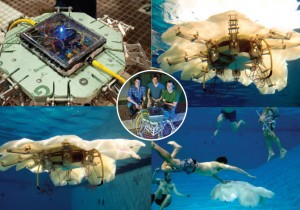Watch where you’re swimming while on vacation this summer so as not to run into one of these giant jellyfish! Mechanical engineers at Virginia Tech have been busy developing an autonomous underwater robot that looks just like a jellyfish and acts like one too. It moves about just like the real thing in all depths and temperature ranges. The 170-pound robo-jellyfish prototype named Cyro can be used to “monitor ocean currents or enemy combatants, study aquatic life, or map the sea floor” (Prism Magazine). The project is funded by the US Navy.
Likewise, here at McGill, engineers from McGill’s Mobile Robotics Lab, School of Computer Science and the Centre for Intelligent Machines, along with partners at York University and Dalhousie University, have been busy developing their own autonomous underwater robot called the AQUA Robot that uses its six flippers to swim. Like Cyro, the AQUA Robot can be used for studying marine habitats. It “can explore underwater environments and gather data with minimum disturbance of the indigenous marine life” (The AQUA Project).
Watch how it moves here.
Perhaps you’ll have a chance to see the AQUA Robot live in action by participating in McGill’s Barbados Field Study Semester where it is known to swim in the clear, warm waters off the coast of the Bellairs Research Institute in Holetown, Barbados.
Even if your vacation doesn’t take you to any exotic locations this summer, you might still have a chance to spy the AQUA Robot at the McGill Athletics swimming pool where it performs its tests. And if that’s not enough, you can even buy one of your own!
Happy and safe swimming this summer with or without the underwater robot!
Image from Prism Magazine

